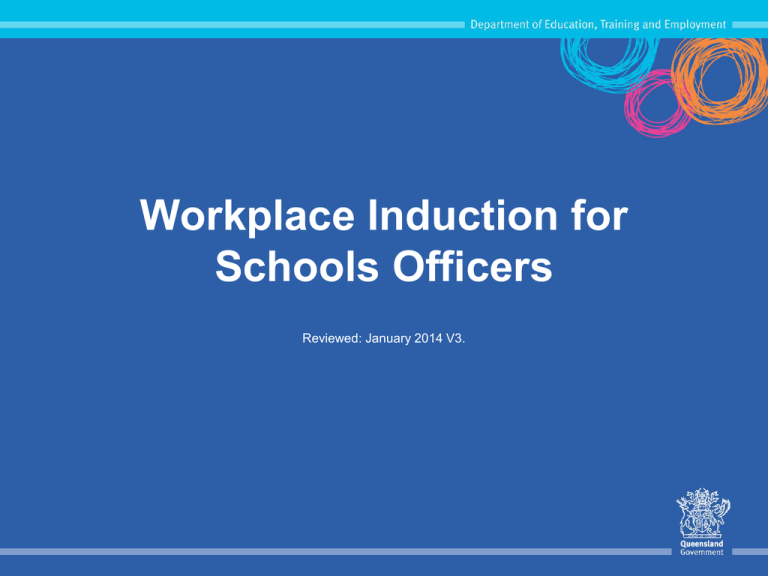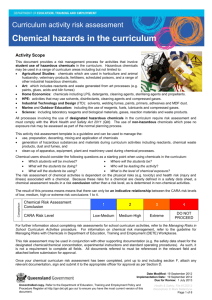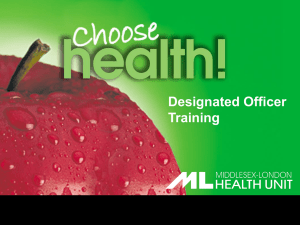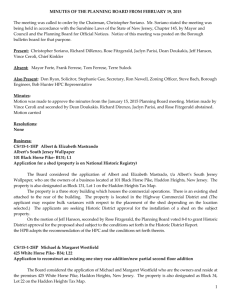Schools Officers` Induction presentation
advertisement

Workplace Induction for Schools Officers Reviewed: January 2014 V3. Induction resources Schools Officer Induction training resources can be accessed at http://deta.qld.gov.au/about/induction/ eq/support-staff/school-officers.html Policies and Procedures Employment details Pay details, general working conditions, personal details. Corporate Documents Code of Conduct, Procedures Register Creating Healthier Workplaces website Local Procedures Emergency procedures Purchasing Security Housekeeping Housekeeping Safe Housekeeping Tips • Ensure appropriate safe, clear access • Organise storage of materials and plant • Collect and dispose of rubbish & unused items • Keep maintenance and repair records • Secure the shed or chemicals/equipment • Display safety signage/information (i.e. SOPS) • Regularly inspect your work areas. Sun Safety Skin Cancer in Australia • Australia has the highest rate of skin cancer in the world. • About 1500 Australians die every year from skin cancer related to ultraviolet radiation exposure. • EQ supports a Sun Smart school environment. • Schools Officers are provided with Sun Smart clothing that must be worn when working outside. Machinery & Equipment Safety Understand how to operate equipment safely: • • • • • Refer to Safe Operating Procedures Refer to Manufacturers manuals and instructions Undertake training when required e.g. chainsaw use Ask experienced operators Do not remove, disable or alter any safety feature. Use resources and keep records: • Safe Operating Procedures • Equipment Maintenance Records http://education.qld.gov.au/health/safety/hazards/equip-resources.html Use Personal Protective Equipment (PPE) http://education.qld.gov.au/health/pdfs/healthsafety/ppe.pdf Machinery & Equipment Safety What do you need to do to be safe with tools? 1. Use the right tool for the job 2. Operate according to the manufacturer's instructions and within design limitations 3. Know how to use the tool safely and properly 4. Keep all tools in good condition with regular maintenance 5. Examine each tool for damage before use 6. Provide and use the proper PPE Personal Protective Equipment • Have it with you every day • Ensure you know how to use it • Select and use the right gear • Keep it in good condition • Store in clean containers • Replace it if damaged Hearing Loss Hearing loss • causes no pain • causes no visible trauma • leaves no visible scars • is unnoticeable in its early stages • accumulates with each over-exposure • takes years to diagnose Noise induced hearing loss is PREVENTABLE. Once your hearing is gone it will never come back. Protect your HEARING - you won't get a second chance. 10 Chemicals Chemicals that can be used in your school may include some insecticides and herbicides, paints, thinners, fuels and oils, gases and pool chlorine. You must not use any listed prohibited substances. • Read instructions/labels and get copy of a Safety Data Sheet (SDS) before you use the chemical. • A SDS is a general guide for use of chemicals • • • effects on body/humans and first aid instructions precautions for use and emergency procedures safe storage and handling including PPE • Workplaces must: • • • keep a register of the hazardous chemicals used have a copy of a current (<5 years old) SDS of the substance make the register available to all relevant persons 11 Chemicals • Storage of Chemicals: – Clean, tidy and lockable – Cupboards/bunding used when required – Chemicals are segregated when required • Handling of Chemicals: – Preparation area is well lit and ventilated – Plenty of bench space to work – Access to clean water and first aid • Associated Equipment: – Functional, safe and well maintained – Related records are current 12 Asbestos Management and BEMIR • The location and condition of asbestos containing materials (ACM) is recorded in the Built Environment Materials Information Register (BEMIR). • Asbestos products shall only be handled by qualified service providers. • All service providers undertaking any maintenance or construction work must obtain a Work Area Access Permit (WAAP) issued through BEMIR. • Service provider to certify that work is complete in the WAAP and the space is available for re-use. • Report any changes in the condition of ACM to the Administration Office. 13 Working at Heights There is a prohibition on DETE staff, students and volunteers accessing or working on roofs at all Education Queensland facilities You should always attempt to undertake any work heights from ground level or a stable work platform before using other methods. Working at heights should ONLY be performed by school staff when there are appropriate practices in place to prevent a person from falling. 14 Working at Heights “Falls from heights can cause serious injuries…” Do you really need to leave the ground to do a job? E.g. – retrieving items from roofs – clearing gutters or maintenance work If Yes, consider: – – – – The appropriate equipment you will need Training where required Risk assessment and/or SWMS to do the job How to minimise the frequency of these tasks 15 Working at Heights • Use tools to assist with tasks • Use contractors – trained people with the right equipment • Use other equipment to access heights when required e.g. hire equipment • Stay off ladders if at all possible • Ensure the ladder is safe if you use one 16 Working at Heights – minimising risks What are some options for you avoid injury? • Trim branches on trees near buildings • Organise for play areas to be away from buildings • Use gutter vacs or good quality gutter guard • Use skilled contractors for work at heights • Use alternative methods to install/hang items on high walls/ceilings 17 Manual Handling 18 Manual Handling What’s the problem? Schools Officers have very high sprain/strain injury rates WHY? Because your jobs are physically demanding made up of mostly Manual Tasks 19 Manual Handling – injury causes • Exertion – Moving furniture, gardening • Awkward or Sustained positions – Mowing/Slasher – Maintenance work (reaching above head) • Long Duration or High Repetition • Vibration – Tool use – Tractors/mowers 20 Manual Handling – preventing injury Design the job so it is easier – • the way it is done (order, delivery, tools) • Where the task is done (closer, more comfortable, away from other) • Use equipment or mechanical assistance to help you; trolley, cart, long handled tool for leverage. Manage your exposure to the risks • Organising the work (breaking up the tasks during the day) • Task-specific training (making sure you are doing it the best way possible) 21 Manual Handling Don’t lift or handle more than can be easily managed. There is a difference between what you can lift and what you can safely lift. If in doubt - get help. 22 Manual Handling What can you do to make your work safer? • • • • • • • Think about each task Plan the task – and plan each lift Use team lifting and mechanical devices Plan your day for variety Rest and alternate use of muscle groups Maintain good postures Do NOT put yourself at risk 23 Infection Control • Due to their nature, DETE workplaces such as schools can be natural amplifiers of infectious disease. E.g. large numbers of people congregating in close proximity on a daily basis. • An Infection Control Program is important to minimising the spread of infectious disease. 24 Infection Control What are standard precautions? Assume that all blood and bodily fluids/substances are potentially infectious and therefore apply: – – – – – Good hygiene including hand washing Use of personal protective equipment Appropriate waste disposal Cleaning and sanitation Know your immunisation status (e.g. all common childhood illnesses as well as Hepatitis A and Hepatitis B) Infection Control Infectious diseases may be: • Blood borne e.g. Hepatitis B • Airborne / droplet e.g. Influenza • Transferred via contact e.g. Gastroenteritis Control measures to prevent infection are based on the method of transmission. Schools Officers are considered “at risk” of contracting Hepatitis A and B and are therefore able to access school funded vaccination. 26 How do you keep safe? • Most incidents can be avoided • Rules are not made to be broken • You have responsibilities to yourself and others to work safely in a healthy and safe environment • Know what is happening around you • Comply with your legal duties • Report potentially dangerous situations or practices • Remove, cover, signpost or barricade where practical - don’t leave it for others 27











